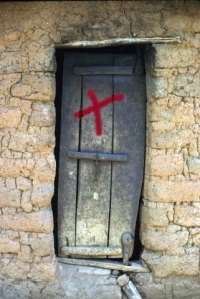Black Death Cross
and Plague Cross

It is mid-14th century. A group of monks with a red cross sewn to the front and back of their robes are weaving through Europe on a bizarre mission: Not spreading the word of salvation, not feeding the poor, and not tending the sick. Their vocation is to atone for man's sin.
Europe is in the grip of a bubonic plague. The robed figures gather in the town square to perform their daily cleansing ritual. Using leather whips barbed with sharp iron spikes, they whip themselves until they bleed.
Self flagellation is not restricted to Christianity; some Muslim and Hindu sects also employ this as a means to enter a trance-like state, which an outsider might imagine reduces both the devotional and penitential value.
This is the only way they know to combat the cursed pestilence.
Meanwhile, a black rat infected with the bacteria Yersinia pestis, is bitten by a flea. The flea sucks in the bacillus which quickly proliferates in the flea's throat and prevents food from entering its stomach. The flea feels hungry and goes on a feeding binge, from one rat to another. It sucks blood from each victim voraciously, but the blood cannot pass into the stomach, so it is regurgitated back into the host along with sufficient bacillus to infect the rat.
The rats die from the disease very quickly and the vermin population declines. To satisfy its desperate hunger, the flea must find an alternative source of blood.

Man.
Any human is suitable, the flea is not fussy. Just hungry. The bacteria enters the person's body and quickly replicates itself during its cardiovascular tour around the body, swelling lymph glands (buboes) and creating black ulcers on the skin (hence the common name 'Black Death').
Every organ is attacked: lungs, liver, spleen, kidneys, and after a few days of fever, headache, weakness, vomitting and intense pain, the victim dies. The body is deemed to be highly contagious and too dangerous to be moved so is left on the bed. With few able-bodied people remaining to deal with the corpse, it is left to rot. The only thing the town's watchman can do is to copy the symbol used by the monks and paint a red cross on the door of the house, warning people not to enter.
Fear and mistrust grip communities. A cross is erected just outside the town where farmers can come during the morning to deposit food produce for the townsfolk, then scurry back to their farms. When the church bell gives the signal, people from the town go to pick up the produce and drop their payment into a strongbox which is filled with holy water. The priest blesses the cross and the water to ensure the coins are not infected. This cross is known as the Plague Cross. (Mass graves of victims are marked by a stone cross, also called a Plague Cross.)
It is estimated that one third of Europe's population was wiped out by the Black Death in the 14th century before the plague subsided. But the curse didn't disappear completely.
In 1665 it returns with a vengeance in London. Still no cure, and to prevent the pestilence from spreading, victims are quarantined in their houses, usually with the whole family. Once again, the dreaded red cross is seen daubed on people's doors along with the words: "Lord have mercy upon us." Watchmen guard the door to ensure no one enters or leaves. After a few days, the moaning from within goes silent as the entire household perishes.
Ring a ring o'roses
A pocketful of posies
Atishoo! Atishoo!
We all fall down
This nursery rhyme, with its numerous variations, may have originated from the London plague of 1665. Children sing this, holding hands and skipping around a circle, and then collapse to the ground at the end of the rhyme.
One symptom of the plaque was the appearance of rose-red blotches. A sweet smelling posy of flowers would help mask the stench of death. But soon after the sneezing and flu-like symptoms occurred, death would swiftly follow.
We now know that bubonic plague is rarely spread from person to person; rather it's from the bite of an infected flea. Nevertheless, one can understand the 'plague mentality', ostracizing people because of their disease. This also applied to lepers (see Lazarus's Cross). Today, leprosy can be cured, but it's still one of the world's major health problems. And it still carries the stigma attached to it in biblical times. (See Illness Phobia)
Although we may no longer be daubing a red cross on people's doors, an irrational plague mentality is very much a part of the contemporary reaction to HIV and AIDS (see HIV/AIDS Cross). Of course, one must take precautions against the plaque, leprosy and HIV. Curiously, this same plague mentality is seen applied to people with non-contagious disabilities.
What is more curious - let's rephrase that - what is absolutely terrifying, is that the nature of plague makes it one of the preferred bacteria for chemical weapons. Plague pathogens are easily aerosolized and if the horror of natural plague was not enough, several countries including the US, Russia and China, have both the interest and the facilities to spread this disease.
Purely for defence purposes of course...
(See also Yellow Cross and Crenel Cross, Red Cross, Black Cross and Barbee Cross)
It wasn't until the 19th century that microorganisms were understood to cause disease. And in the early 20th century (c 1920) their application for germ warfare was developed.
A related theory is the origin of saying "Bless you!" when somebody sneezes, since there is a grave possibility that the sneezer may soon die.
"War does not determine who is right; only who is left".
See Ignorance is bliss.